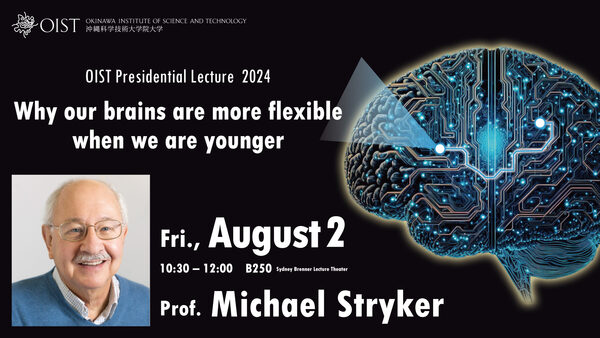Presidential Lecture by Professor Michael Stryker

Description
Why our brains are more flexible when we are younger
Brain plasticity in the adult mammalian brain is different from that in early life. Why? What mechanisms account for this difference?
We have studied this issue recently in the primary visual cortex of mice and previously in other species.
In adult mice, we discovered that activity-dependent plasticity depends on the operation of a cortical circuit composed of specific types of inhibitory interneurons. In contrast, juvenile animals exhibit rapid competitive plasticity during a critical period in early life, which we have shown to depend on several distinct mechanisms, some of which disappear at the end of the critical period. Juvenile plasticity is also associated with rapid millimeter-scale rewiring of connections to and within the cortex, a phenomenon absent in adults. Certain types of embryonic interneurons can create a second critical period of juvenile-style plasticity when transplanted into the adult visual cortex. The cellular signals responsible for this restoration are not yet known.
Machine learning and artificial neural networks were originally inspired by the plasticity of developing visual cortex. In this talk, I will compare the organization of the mouse visual cortex with that of artificial neural networks for vision.
About the Speaker
Michael Stryker earned his Ph.D. from MIT in Peter Schiller’s lab, followed by postdoctoral research with David Hubel and Torsten Wiesel at the Harvard Medical School. In 1978, he joined the University of California, San Francisco (UCSF) Department of Physiology and their nascent neuroscience program as an assistant professor, where he has since remained, except for sabbaticals at Oxford and Scuola Normale Superiore in Pisa.
Stryker co-directed the UCSF graduate program, served as department chair for over 12 years, and directed the Herbert W. Boyer Program in Biological Science. He holds the W.F. Ganong Chair of Physiology at UCSF and has been honored with the W. Alden Spencer Prize from Columbia University and the 2023 Ralph W. Gerard Prize from the Society for Neuroscience. He is an elected member of the American Academy of Arts and Sciences and the National Academy of Sciences.
His research focuses on the role of neural activity in the development and plasticity of precise connections within the central nervous system. Most of his work has been on the visual system, particularly the visual cortex of the mouse in recent years. Current experimental work seeks to understand the cellular and neural circuit mechanisms of activity-dependent cortical plasticity, the interactions between neural activity and molecular cues in the formation of cortical maps, and the difference between the limited plasticity in the adult brain and the much greater plasticity during critical periods in early life. His research utilizes transgenic mice, along with optical and electrical approaches, for recording, labeling, and perturbing connections between specific cells.
***
For inquiries contact: oist_president@oist.jp
Check out recordings of the past Presidential Lectures at OIST here: https://www.oist.jp/about/president/lectures
You can also watch these on YouTube here: https://www.youtube.com/playlist?list=PLxZHT0nOVpvx89gm0x95r-kkcu9AxD2ta
Add Event to My Calendar
Subscribe to the OIST Calendar
See OIST events in your calendar app





